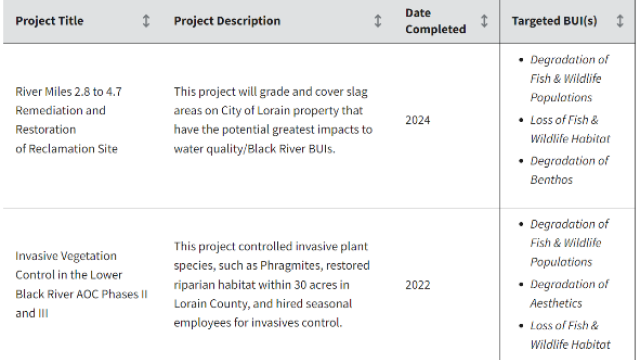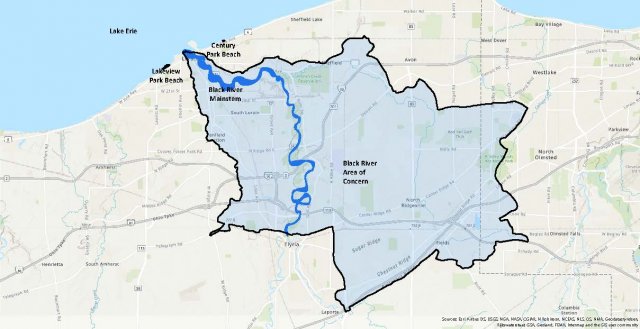Black River AOC
Carla Rosenfeld
(Rosenfeld.Carla@epa.gov)
312-886-4699
News
Overview
Located west of Cleveland in Northern Ohio, the Black River watershed drains into Lake Erie near the city of Lorain. The Black River was once nicknamed the “river of fish tumors” due to its long history of industrial, agricultural, and urban uses, which led to poor water quality, loss of biodiversity, habitat degradation, and sedimentation. Environmental impacts became severe enough for the river to be designated as an Area of Concern (AOC) in 1987.
Historically, the city of Lorain relied on the river for bringing materials to and from its once prosperous industrial center. The river was used as a mode of commerce and was degraded by discharges from industrial operations and wastewater, which contributed to heavy metal and polynuclear aromatic hydrocarbon (PAH) contamination. Other events that played a role in the river’s impairments include:
- Municipal discharges
- Bank erosion
- Commercial and residential development
- Atmospheric deposition of contaminants
- Hazardous waste disposal sites
- Urban stormwater runoff and combined sewer overflows
- Agricultural runoff from the upper watershed
The river provides high-quality aquatic habitat suitable for state-listed endangered, threatened or state-designated “special concern” aquatic animal and plant species.
Beneficial Use Impairments
Beneficial Use Impairments, or BUIs, are designations given by the International Joint Commission (IJC) for an AOC. They recognize various examples of significant environmental degradation. As restoration and cleanup projects make progress, monitoring at the site can show recovery in environmental health. If sufficient recovery is reached, BUIs can be designated as “removed.”
When all BUIs below have been removed, the process of delisting the AOC can begin.
- Restrictions on Fish and Wildlife Consumption (pdf)- Removed October 2016
- Eutrophication or Undesirable Algae (pdf) - Removed October 2016
- Restrictions on Dredging Activities – Removed April 2022
- Degradation of Fish and Wildlife Populations
- Beach Closings - Removed July 2024
- Fish Tumors or Other Deformities - Removed October 2023
- Degradation of Aesthetics (pdf) - Removed January 2021
- Degradation of Benthos
- Loss of Fish and Wildlife Habitat
Remediation and Restoration Work
As of May 2024, all on-the-ground projects, or Management Actions, have been completed at the Black River AOC.
Under a consent decree from U.S. EPA, U.S. Steel dredged 50,000 cubic yards of PAH-contaminated sediment near the company’s coking complex from 1989 to 1990. Since then, EPA and partners have worked to restore the AOC by identifying six habitat restoration management actions. The success of these projects will continue to improve plant and animal populations, help remove BUIs, and contribute to the eventual delisting of the AOC. As the AOC becomes closer to delisting, the City of Lorain and the surrounding area will continue to see ecological benefits of a healthy environment and likely the economic benefits that result from an accessible, healthy waterfront. Because of these efforts, those who live in the area have the potential to see an improved overall quality of life tied to restored local natural resources.
-
Lower Black River Heron Rookery Restoration

Additional Information describing Lower Black River Heron Rookery Restoration project.
-
Table of Projects

Learn more about restoration projects.


